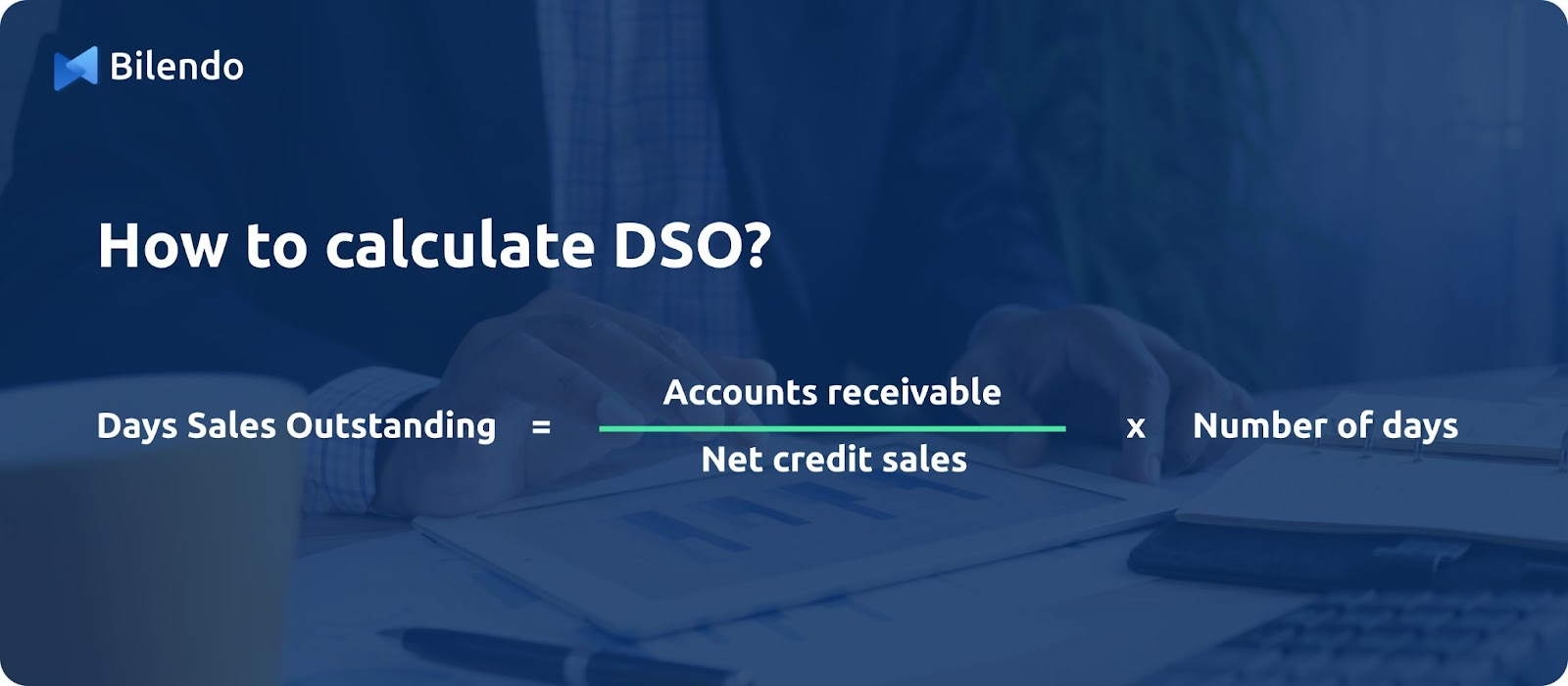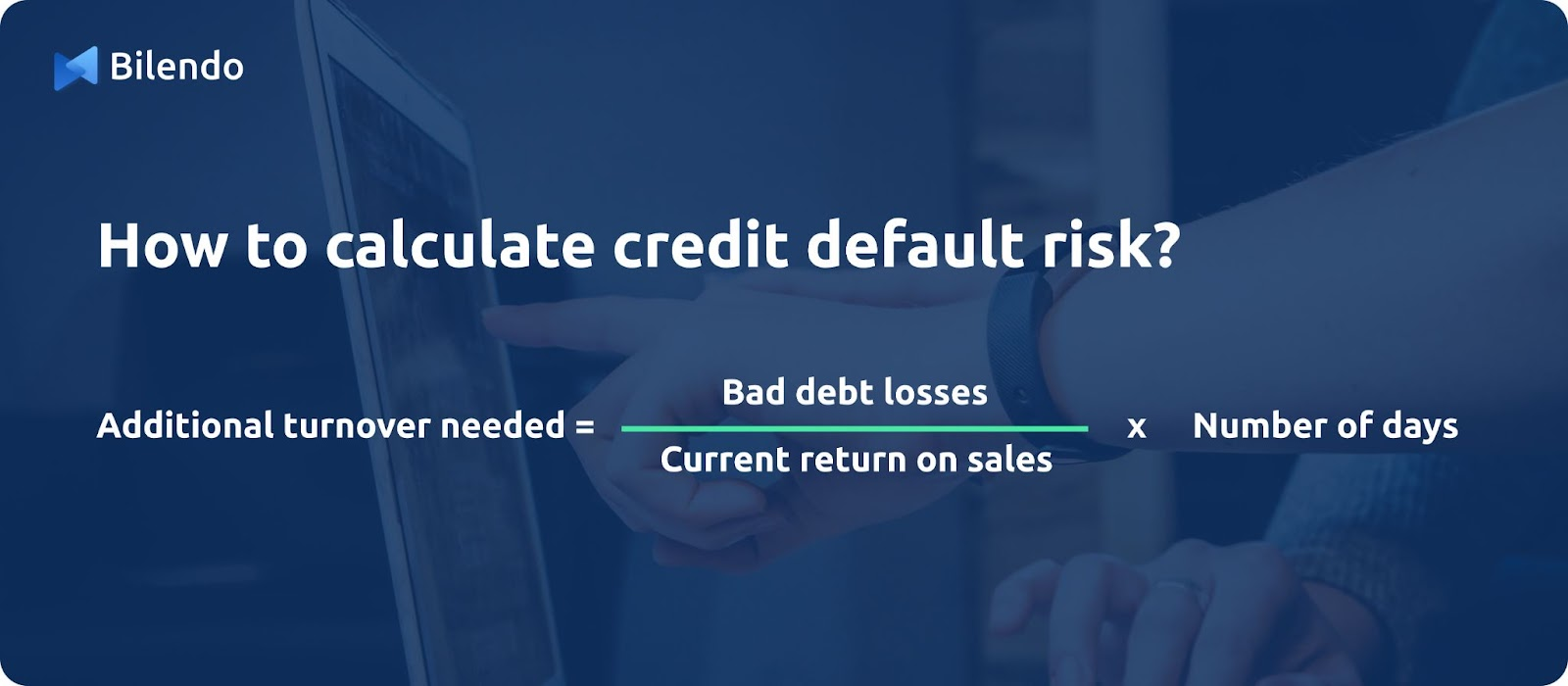As businesses strive for financial success, one metric often overlooked is days sales outstanding (DSO).
But what exactly is DSO, and why should CFOs pay attention to it?
This article explores how CFOs can improve their company’s financial health and manage its cash conversion cycle.
You’ll delve into DSO, including how it’s calculated and what it means for working capital management. You’ll also explore the impact of high and low DSO and examples of how optimizing DSO can positively impact a company’s operating cash flow and overall financial performance.
What is days sales outstanding (DSO)?
Days sales outstanding (DSO) is a financial metric used to measure the average number of days a business takes to collect payment from its customers after a sale. It’s also referred to as the average collection period.
To calculate the DSO, divide the accounts receivables by the total credit sales and multiply the result by the number of days.

Source: Bilendo
- Accounts receivables are the amount of money customers owe to a company.
- Total credit sales is the total amount of sales made on credit during a given period (usually a month or quarter).
- The number of days is the number of days in the same period.
Example: If a company had 100000$ in accounts receivable, 400000$ in credit sales for the month, and the month had 30 days, the DSO value would be: (100000$/400000$) x 30 = 7.5
Derivative: On average, it takes the company 7.5 days to collect payment from its customers after a sale has been made.
With the help of the determined value, conclusions can be drawn about various factors and initiate measures against the associated cash problems. Additionally, DSO is one of the three primary metrics measuring a company’s cash conversion cycle.
Why is DSO so important?
DSO measures a company’s financial health. When companies constantly monitor their DSO, they gain interesting insights into their cash flow and working capital management.
Proper cash flow and working capital management are critical to a company’s performance and growth. When a company’s collections process is inefficient and payments are not received on time, the likelihood of a liquidity shortage increases.
Monitoring DSO over time allows you to identify trends and adjust your sales and collections processes to improve cash flow. For example, adjusting your credit policy reduces the risk of customers defaulting on payments.
Moreover, you can use DSO as a benchmarking tool to compare your performance with your peers in the same industry. Comparing your DSO to your competitors indicates how well you manage your accounts receivables.
If your DSO exceeds your peers, your business takes longer to collect payments. This could signal financial difficulties or inefficiencies in your accounts receivable management process. High DSO can lead to cash flow problems and negatively affect your company’s profitability as you have to wait longer for the already generated revenue.
On the other hand, if your DSO is lower, your company collects payments faster, indicating an efficient and effective accounts receivable management process. This helps improves cash flow, increase profitability, and better manage financial risks.
In general, you should keep DSO as low as possible since a low DSO enables you to use your full financial potential. You also prevent financial losses and avoid insolvency. Low DSO is particularly important for companies with little available capital to keep capital commitments low and capital efficiency high.
Why should companies monitor DSO?
DSO signals effective credit and collection policies.
High DSO values indicate higher credit risk. Due to longer collection periods, you can have higher accounts receivable. This can cause cash flow problems if customers don’t pay on time or in case of bad debt write-offs.
However, DSO isn’t the only valuable indicator of credit risk. External factors (beyond a company’s control) also contribute to the level of credit risk, such as the payment behavior of customers, economic conditions, and industry trends.

High vs. low DSO
Typically, a DSO of 45 days or less is considered favorable. However, a company’s industry heavily influences a good DSO benchmark. Payment behavior, prices, and price structures differ in different industries.
For instance, the retail industry typically expects a lower DSO. It’s also worth noting that businesses that operate on a cash basis, such as supermarkets or gas stations, typically don’t have a DSO. Industries where buying on credit is common generally have a higher DSO. Construction, electronics, and machinery are the sectors with the highest DSO, more than 80 days.
Your business strategy should also follow the DSO industry average, especially when expanding or moving to a new country. Checking the DSO average in the relevant industry greatly helps since the values from other sectors and areas shouldn’t be used as target values for all sectors.
What should companies do when they have a high DSO?
A company with a high DSO should first determine the factors that contributed to it. Here are some possible factors for a high DSO:
- Sales teams extending payment terms to customers to boost sales
- Customers being encouraged to buy products on credit, so they buy more products or services
- The efficiency of the collection process and the factors that slow it
- Credit issues for customers with negative credit ratings
High DSO mandates quick action. The cash flow and the risk of bad debt increase with missed payments and sluggish process improvements.
Take these steps to minimize DSO and avoid degrading your financial performance.
-
- Adjust payment conditions. Not every customer is the same, and their payment habits or abilities may differ. For example, setting stricter payment terms upfront for customers who take more time to pay their invoices is advisable. But don’t forget to be kind in your communication, no matter their financial standing.
- Optimize invoicing. By improving the invoicing process, you can reduce payment disputes and delays. Make sure your invoices are accurate, complete, and send them out on time.
- Better accounts receivable management. Invest in efficient payment monitoring to remind customers of unpaid invoices and define clear collection processes. Accounts receivable automation software automates the dunning process to monitor payments more precisely and efficiently and accelerate the collection process. After all, you’re setting claims for services already delivered. You need the money for running costs and new projects or investments.
- Improve credit management. Consider other measures to reduce DSO as part of credit risk management. Consistently monitor each customer’s creditworthiness to identify changes and adjust the payment method. Additionally, good customer communication helps you stay in close touch with customers and be informed about their requests, questions, and problems.
- Offer early payment incentives. Offer customers early payment incentives – the most common offer is an early payment rebate.
- Reduce error rate. Manual work is error-prone, especially in lengthy processes with many work steps; something can easily be overlooked, delayed, wasted, or simply forgotten. Finding errors, fixing them, and then rebalancing them is expensive, time-consuming, and incredibly annoying. Automating accounts receivable processes reduces the error rate and streamlines the flow of outgoing invoices and incoming payments.
What does a low DSO indicate?
A low DSO indicates efficient and smooth collection processes. Reminders are sent in good time, which means customers pay on time. The accounts receivables, therefore, don’t restrict the company’s liquidity, and it can pursue new investments.
Why is optimizing DSO hard?
Optimizing DSO can be difficult for many reasons, most notably because some companies have no control over it. Below are the most common reasons companies struggle to lower their DSO:
- Customer behavior: Businesses cannot predict when their customers will pay. While some customers may use their own payment methods, others are reluctant to pay for various factors, including financial difficulties.
- Customer disputes: Payment delays may occur due to disputed invoices. Resolving a customer’s disagreement over an invoice can take time before payment is received. Most companies resolve disputed invoices inefficiently, wasting much of their resources.
How to optimize DSO
Work out a DSO strategy to keep the DSO as low as possible and maximize your liquidity. Set a target DSO that aligns with your current working capital and the pattern it has shown in the past. To set the right target DSO, consider how far free cash flow can drop. Also, check your potential customers’ creditworthiness and gather detailed information about their payment behavior.
How do you benefit from using DSO correctly?
You derive a number of benefits from effectively managing DSO.
- Improved cash flow: Lowering DSO accelerates collections, improving cash flow and providing more working capital.
- Reduced financial risk: A company with a high DSO risk increased borrowing costs, liquidity problems, and an inability to pay its creditors or suppliers. Successful DSO management mitigates these risks and ensures the company has the resources to make timely repayments.
- Profitability boost: Businesses that manage their DSO effectively increase profitability by reducing the cost of financing their receivables. This allows them to borrow less to fund their operations when the DSO is lower.
- Better customer relationships: Effective DSO management improves customer interactions. Businesses better serve their customers and generate more repeat business by collecting payments faster and more efficiently.
The relationship between working capital and DSO
Working capital is the amount of money a company has available to meet its day-to-day expenses and short-term financial obligations. It’s the difference between current assets and current liabilities.
Cash accounts receivable and inventories are current assets because they can be converted into cash within a year. Current liabilities such as accounts payable, short-term loans, and accrued expenses are due within one year.
Positive DSO means that part of the current assets is financed with long-term capital. On the other negative DSO signals that the current assets aren’t sufficient to cover the short-term liabilities. Part of the fixed assets is therefore financed in the short term. With a negative DSO, the company can quickly run into liquidity in the future.
Simply put, the higher the working capital, the more secure the liquidity.
Additionally, DSO affects cash flow, which affects the amount of money available to pay off short-term debt and day-to-day expenses. A company can improve its working capital situation and ensure it has sufficient cash to meet its obligations by properly controlling DSO.
What does DSO mean in accounting and finance?
Businesses that keep tabs on their DSO can identify patterns and optimize their sales and collections processes to increase cash flow and profitability. Use DSO as a benchmarking tool to determine how well you perform compared to your competitors and what you need to improve your payment process in the long term.
Accounting is no longer the paper jam it used to be. See how AI is transforming accounting and optimizing workflows.

